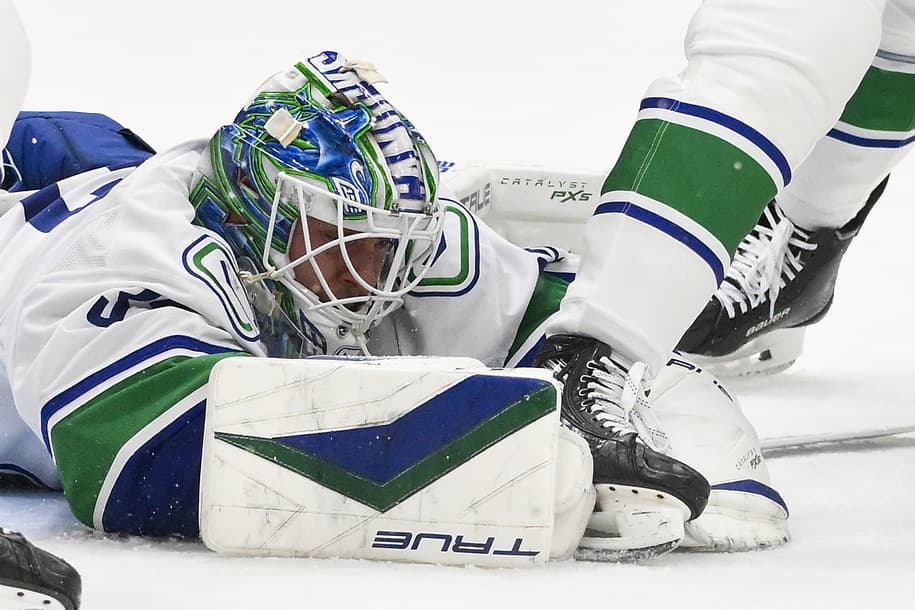Nation Sites
The Nation Network
CanucksArmy has no direct affiliation to the Vancouver Canucks, Canucks Sports & Entertainment, NHL, or NHLPA
The Kevin Lankinen contract is a good deal by any measure, and potentially a great one for the Canucks

Photo credit: © Jeff Curry-Imagn Images
Feb 24, 2025, 14:40 EST
The Vancouver Canucks have decided to commit to Kevin Lankinen.
Hot on the heels of his having stolen the Team Finland crease from Juuse Saros at the 4 Nations Face-Off, GM Patrik Allvin announced that the Canucks had come to terms with Lankinen on a five-year extension with a $4.5 million AAV. If that term and salary weren’t enough evidence of commitment, there is also the full no-movement clause attached to the first two seasons, followed by three years of a 15-team no-trade clause.
It’s as of yet impossible to know what this contract means for the future of the Canucks’ other goaltender, Thatcher Demko. But it is clear that moving forward, Lankinen will either be sharing the Vancouver starting duties (in a 1A/1B situation) or taking those reins over entirely for himself.
This makes his contract a pretty important one to this franchise’s immediate and near-future success. Thankfully, it has all the makings of a pretty darn good one. Potentially, even a great one.
Let’s start with the raw numbers and rankings. Lankinen’s $4.5 million AAV currently has him slotted in a tie for the 21st-highest-paid goaltender in the league as of next season, 2025/26. One could certainly make an argument for Lankinen being a top-20 goalie at the current moment, but that’s not even really necessary to justify this contract.
Remember that the NHL’s cap ceiling is skyrocketing both this summer and for the next two. Any salary signed before that explosion in cap space is going to age well in relative comparison. And that process should start before the 2025/26 season begins.
We can look at Lankinen’s former fellow crop of UFA netminders and find a few who will sign contracts over and above a $4.5 million value this offseason. Adin Hill, for one. Karel Vejmelka, for another. Possibly Charlie Lindgren, as well.
So, already, we will find that Lankinen begins the 2025/26 season ranked somewhere in the mid-20s in terms of goalie cap hits. And he will slide further down that list in each of the subsequent five years of his contract.
That could be called ‘low-end starter’ money. But that might not even be entirely accurate because it’s tough to say that all 32 NHL franchises have genuine starting goaltenders right now. The actual number is somewhere in the 20s, too, and so we should probably state that $4.5 million is either extremely low-end starter money or a little below average for a ‘1A/1B’ tandem-type or on the high-end for a backup.
Given that Lankinen has never been anything less than a high-end backup at any point in his career, this would seem like a safe bet that will only get safer as inflation impacts NHL salaries.
And in this 2024/25 season, Lankinen is significantly more than a high-end backup.
As of this writing, he ranks 18th in games played and is tied for 15th in wins, with seven overtime losses attached to that record. His save percentage of .907 is ranked 19th overall among starters, and his goals against average of 2.52 is tied for ninth.
Those are all numbers achieved on a Vancouver roster that has, at best, had an up-and-down season. It was a season that would have had significantly fewer ups and considerably greater downs had Lankinen not been around to steal games.
Look at Lankinen’s body of work this season, and it’s hard to argue he’s not worth at least $4.5 million, probably more than that.
However, the argument against this contract has to do with more than just this year. It’s about the longer-term track record. You’ll hear some folks opine that this deal – if not its salary, then certainly its term – is too much trust to give to someone who has been a ‘career backup.’
But that’s not really the fairest description of Lankinen.
We’re only talking about a five-year career here. Lankinen didn’t arrive in the NHL until the age of 25 when he made 37 starts for the Chicago Blackhawks as a rookie in a pandemic-shortened 2020/21 season. Those were the most starts of his career thus far (although he’s about to pass that shortly) and more than double that of any other Blackhawk goaltender. In other words, Lankinen started out his career as a starter, ending up with a .909 save percentage on a bad Chicago team and even picking up a handful of Calder votes.
Lankinen definitely fell victim to the dreaded sophomore slump. The Blackhawks brought in Marc-Andre Fleury to platoon with him, but Lankinen’s numbers dipped across the board. And soon enough, Fleury was the undisputed starter, and Lankinen was looking for a new team.
Well, he found one in Nashville. But what he did not find was an opportunity to start. That’s because he signed on with a team already in possession of Juuse Saros, simply one of the best, most consistent, and healthiest goalies in the modern NHL. In other words, Lankinen went to a team on which it was virtually impossible to steal the starting gig – not that he didn’t make a good run at it.
For two years in Nashville, Lankinen was among the league’s best backups. In 2022/23, he played in 19 games with a winning record, a career-high .916 save percentage, and a 2.81 GAA that he’s only now beating in Vancouver. He followed that up with a 2023/24 season of 24 games played, an 11-6-0 record, and a .908 save percentage.
Then he came to Vancouver.
If one counts Lankinen as the Canucks’ starter in the present moment, as they probably should. That means he’s gone starter, backup, backup, backup, starter over the course of his five-year career. Sure, that might technically make him a ‘career backup’ by some standards, but only barely, and with some major complicating circumstances playing a role.
What it doesn’t make him is low on experience.
Since Lankinen entered the league, he’s appeared in 147 games, the 35th most among goalies. By the end of the year, he should pass enough of the names ahead of him to wind up in the top 32.
Only 14 goalies have played over 200 games over the same span. So, it’s true that Lankinen is a little light on experience compared to that set. But then he basically has as much experience as anyone else. And when we look at that list of folks with more experience, we see some clearly worse goaltenders (Tristan Jarry, Alexandar Georgiev) or those approaching the ends of their careers (Fleury).
In terms of goalies with sustainable long-term careers ahead of them, we’ve got Lankinen ranked somewhere around 15th or 16th overall in terms of games played. That’s not exactly ‘inexperienced,’ is it? It’s not the kind of track record that would ever win a goalie a bank-breaking $11.5 million salary like the one Igor Shesterkin just signed. But a contract that is less than half of that?
Lankinen would seem to have more than enough track record to justify that.
There are a few other arguments against this contract being a great one. It covers Lankinen from ages 30 to 34, which certainly contains years in which a goalie might theoretically fall off – though we’ll note that Lankinen’s late start to his career and years as backup might have left more leeway on his odometer than his age would suggest.
There is also the fact that Lankinen has yet to start a playoff game.
But those are the only things that could get in the way of this contract having truly exceptional value. Think about it. If Lankinen puts together five good years of this same quality of play and proves himself capable in the postseason? And the Canucks have him under contract for just $4.5 million? Well, now that becomes one of the best goaltending contracts in the NHL, period.
The contract may be even better considering the cap-related inflation going on. By year two or three of this deal, Lankinen could be ranked somewhere in the 30s for goalie salaries, and it’s certainly hoped he’ll remain better than just a top-30 goalie.
We’ve talked a lot about the sticker shock that will come with UFA signings this summer and into the next summers. Everything is going to seem a lot more expensive all of a sudden and will take some getting used to. That Lankinen’s new contract doesn’t seem out of line right now really says something and virtually guarantees it only looks better in the months and years to come.
This is all buoyed by the fact that Lankinen’s salary will remain below average for an NHL starter, which leaves plenty of room for an expensive backup, or another 1A/1B type, throughout the term of this contract. Maybe that costly backup is Demko at $5 million for next year; maybe it’s someone else. However, the nature of the contract itself all but ensures Lankinen won’t ever need to be overworked in Vancouver and should remain well-supported. If not by a pricey backup, then by the money that would have been spent on a pricey backup being spent elsewhere on the roster.
We think there is enough evidence here to state that this is a good contract at the present moment and that it’s got a better-than-decent chance of remaining that throughout its five-year term. But it also has the potential to become a truly great contract if Lankinen can continue to translate his current level of play to more full-time, long-term starting duties – and we believe that is well within the realm of possibility.
Sponsored by bet365
Breaking News
- Canucks sign Max Sasson to two-year contract extension
- NHL Draft: Who sits at the top of the 2026 class if the Canucks pick there?
- 3 Canucks Stars of the Week: Quinn Hughes’ last dance
- The Farmies: Victor Mancini goes coast-to-coast, but Abbotsford Canucks fall short in overtime
- The Statsies: Buium and Rossi make strong statements in Canucks win against Devils
